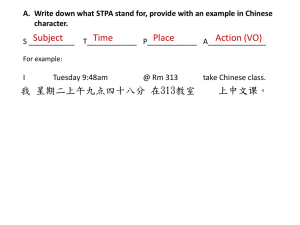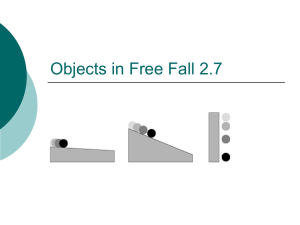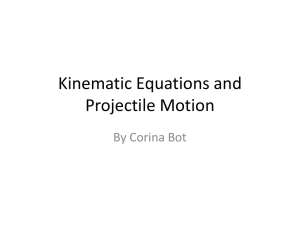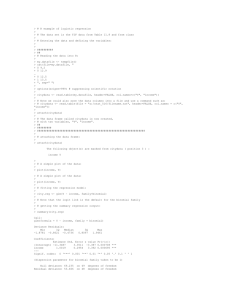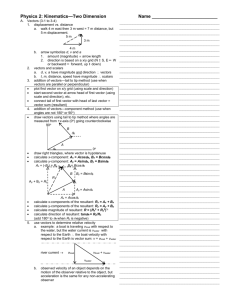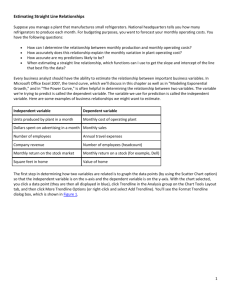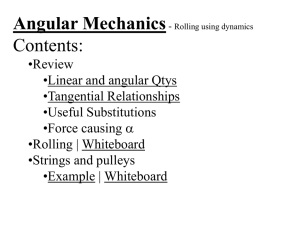Proj
advertisement
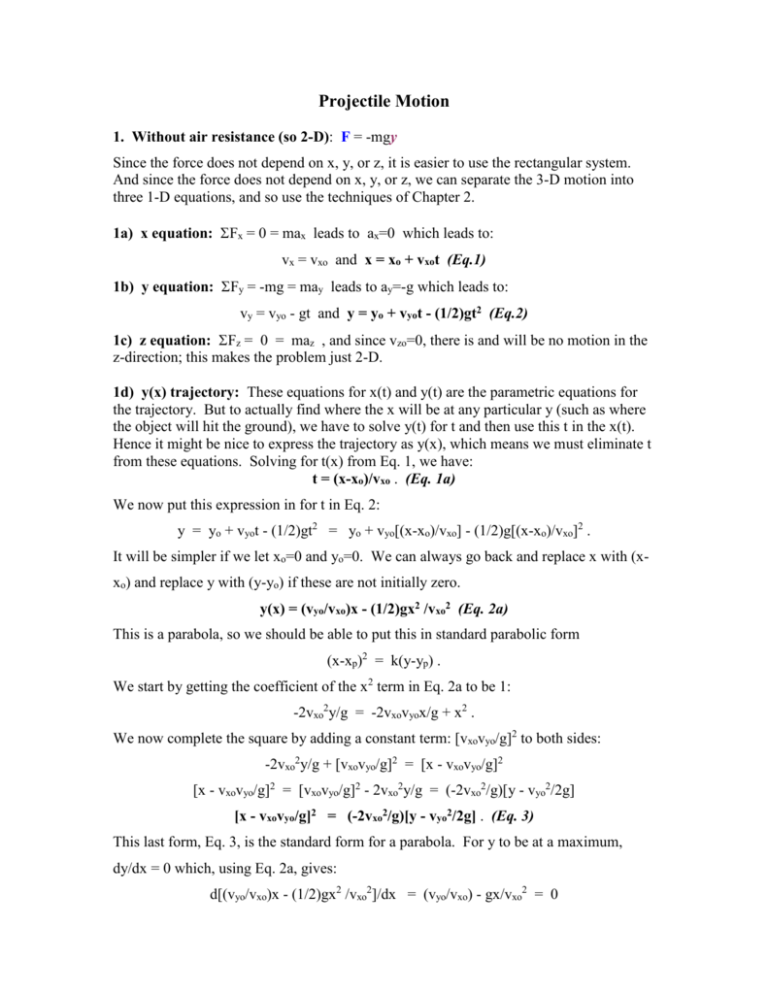
Projectile Motion
1. Without air resistance (so 2-D): F = -mgy
Since the force does not depend on x, y, or z, it is easier to use the rectangular system.
And since the force does not depend on x, y, or z, we can separate the 3-D motion into
three 1-D equations, and so use the techniques of Chapter 2.
1a) x equation: Fx = 0 = max leads to ax=0 which leads to:
vx = vxo and x = xo + vxot (Eq.1)
1b) y equation: Fy = -mg = may leads to ay=-g which leads to:
vy = vyo - gt and y = yo + vyot - (1/2)gt2 (Eq.2)
1c) z equation: Fz = 0 = maz , and since vzo=0, there is and will be no motion in the
z-direction; this makes the problem just 2-D.
1d) y(x) trajectory: These equations for x(t) and y(t) are the parametric equations for
the trajectory. But to actually find where the x will be at any particular y (such as where
the object will hit the ground), we have to solve y(t) for t and then use this t in the x(t).
Hence it might be nice to express the trajectory as y(x), which means we must eliminate t
from these equations. Solving for t(x) from Eq. 1, we have:
t = (x-xo)/vxo . (Eq. 1a)
We now put this expression in for t in Eq. 2:
y = yo + vyot - (1/2)gt2 = yo + vyo[(x-xo)/vxo] - (1/2)g[(x-xo)/vxo]2 .
It will be simpler if we let xo=0 and yo=0. We can always go back and replace x with (xxo) and replace y with (y-yo) if these are not initially zero.
y(x) = (vyo/vxo)x - (1/2)gx2 /vxo2 (Eq. 2a)
This is a parabola, so we should be able to put this in standard parabolic form
(x-xp)2 = k(y-yp) .
We start by getting the coefficient of the x2 term in Eq. 2a to be 1:
-2vxo2y/g = -2vxovyox/g + x2 .
We now complete the square by adding a constant term: [vxovyo/g]2 to both sides:
-2vxo2y/g + [vxovyo/g]2 = [x - vxovyo/g]2
[x - vxovyo/g]2 = [vxovyo/g]2 - 2vxo2y/g = (-2vxo2/g)[y - vyo2/2g]
[x - vxovyo/g]2 = (-2vxo2/g)[y - vyo2/2g] . (Eq. 3)
This last form, Eq. 3, is the standard form for a parabola. For y to be at a maximum,
dy/dx = 0 which, using Eq. 2a, gives:
d[(vyo/vxo)x - (1/2)gx2 /vxo2]/dx = (vyo/vxo) - gx/vxo2 = 0
which means that xpeak = vxovyo/g for y at its peak. But this means that ypeak = vyo2/2g .
Thus Eq. 3 becomes:
[x - xpeak]2 = (-2vxo2/g)[y - ypeak] . (Eq. 3a)
1e) Range: This form (Eq. 3) also allows an easy calculation of the range of the
trajectory (that is, the value of x when y=0). [Remember that by substituting y=0 into Eq.
3, we are also assuming yo=0 as well.]
[xrange - xpeak]2 = (-2vxo2/g)[0 - ypeak] = 2vxo2ypeak/g = 2vxo2[vyo2/2g]/g = vxo2vyo2/g2
xrange = xpeak + vxovyo/g = vxovyo/g + vxovyo/g = 2 vxovyo/g = xrange . (Eq. 4)
2. With air resistance, but no wind (so still 2-D): F = -mgy - bv
Since the force does not depend on x, y, or z, and since the force depends linearly on v
(that is, Fx depends on vx but not vy or vz, etc), it is easier to use the rectangular system
and separate the 3-D motion into three 1-D equations. . [Note: we could use a resistive force
that is proportional to v2 which would be more realistic. It could also be broken into rectangular
components, e.g., FAR-y = -bvvy . However, this adds a complication since v = SQRT[vx2 + vy2 + vz2].
2a) x equation: Fx = -bvx = max = m dvx/dt .
Using the form: -bvx = m dvx/dt gives the expression:
(-b/m)dt = dvx/vx .
Integrating both sides gives:
t
0
(-b/m) dt =
vx
vxo
dvx/vx
which integrates to
-bt/m = ln[vx/vxo]
or
t = (-b/m) ln[vx/vxo] ,
or solving for vx(t): vx(t) = vxo e-bt/m .
To get x(t), we use dx/dt = vx(t), or dx = vxo e-bt/m dt . Integrating gives:
x
xo
dx =
t
0
vx(t) dt =
t
0
vxo e-bt/m dt , or
x - xo = (-m/b)vxo e-bt/m - (-m/b)vxo e0 = (mvxo/b)(1 - e-bt/m) . (Eq. 5)
Anticipating the need to put t(x) into the y(t) equation to get y(x), we try to invert Eq. 5 to
get t(x). As before, we will assume xo=0 since we will always be able to replace x with
(x-xo) if that is not true.
x = (mvxo/b)(1 - e-bt/m) (Eq. 5) becomes
(bx/mvxo) = (1 - e-bt/m)
e-bt/m = 1 - (bx/mvxo),
or
(Eq. 5a), or
t = (-m/b) ln[1 - (bx/mvxo)] . (Eq. 5b)
2b) y equation: Fy = -mg -bvy = may = m dvy/dt .
Using the form: -mg -bvy = m dvy/dt gives the expression:
(-b/m)dt = dvy/(vy+mg/b) .
Integrating both sides gives:
t
0
(-b/m) dt =
vy
vyo
dvy/(vy+mg/b) .
If we let u = (vy+mg/b), then du = dvy and we have:
-bt/m =
vy+mg/b
vyo+mg/b
du/u = ln[(vy+mg/b)/(vyo+mg/b)] .
We now have essentially t(vy). Inverting to get vy(t):
(vy+mg/b)/(vyo+mg/b) = e-bt/m , or
(vy+mg/b) = (vyo+mg/b) e-bt/m , or
vy = -(mg/b) + (vyo+mg/b) e-bt/m , or
vy = vyoe-bt/m - (mg/b)(1 - e-bt/m) . (Eq. 6)
To get y(t), we use dy/dt = vy(t) = vyoe-bt/m - (mg/b)(1 - e-bt/m) . Integrating this gives:
y
yo
dy = ot [vyoe-bt/m - (mg/b)(1 - e-bt/m)] dt ,
which upon integrating term by term gives:
y - yo = -(mvyo/b)(e-bt/m - 1) - (mg/b)t -(m/b)(mg/b)(e-bt/m - 1) .
As before, we will assume yo=0 since we will always be able to replace y with (y-yo) if
that is not true. Upon a slight re-arrangement of terms, we have:
y(t) = - (mg/b)t + (m2g/b2 + mvyo/b)(1 - e-bt/m ) . Eq. (7)
Before we proceed to try to get y(x), let's look at the z component.
2c) z equation: Fz = -bvz = maz , and since vzo=0, there is and will be no motion in
the z-direction; this makes the problem just 2-D.
2d) y(x) trajectory: These equations for x(t) and y(t) are the parametric equations for
the trajectory. But to actually find where the x will be at any particular y (such as where
the object will hit the ground), we have to solve y(t) for t and then use this t in the x(t).
Hence it might be nice to express the trajectory as y(x), which means we must eliminate t
from these equations. We use Eq. 5(b) for t and Eq. 5(a) for (1 - e-bt/m) in Eq. (7) to get:
y(t) = - (mg/b) (-m/b) ln[1 - (bx/mvxo)] + (m2g/b2 + mvyo/b) (bx/mvxo) , or
y(x) = (m2g/b2) ln[1 - (bx/mvxo)] + (mg/bvxo + vyo/vxo) x . Eq. (8)
It is hard to compare the result (Eq. 8) for y(x) with the result for no air resistance (Eq. 3).
2e) special case: small air resistance (b is small)
However, we can see if Eq. 8 reduces to Eq. 3 in the case of b=0, and then see the small
corrections to Eq. 3 that Eq. 8 predicts. When b goes to zero, it looks like the factor in
front of the ln blows up. However, the ln goes to zero. How do we see what really
happens? To do this, we can expand the ln in a power series:
ln(1-u) = 0 - u - u2/2 - u3/3 – u4/4 + ... , so as long as u = (bx/mvxo) << 1, we have:
y(x) = (m2g/b2)[0 - (bx/mvxo) - (bx/mvxo)2/2 - (bx/mvxo)3/3 - (bx/mvxo)4/4 - ...) + (mgx/bvxo) + (vyo/vxo)x
= 0 - mgx/bvxo - gx2/2vxo2 - bgx3/3mvxo3 - b2gx4/4m2vxo4 ... + (mgx/bvxo) + (vyo/vxo)x
y(x) = (vyo/vxo)x- gx2/2vxo2- bgx3/3mvxo3 - b2gx4/4m2vxo4 - ... (Eq. 9)
As b goes to zero, y(x) becomes simply y = (vyo/vxo)x- gx2/2vxo2 , which is the same as
we obtained for no air resistance (Eq. 2a). For a small b [such that (bx/mvxo) << 1], we
have the correction from the no air resistance result of: - bgx3/3mvxo3 if we neglect terms
of order b2 and higher. Note that this correction makes y smaller with air resistance than
without, as expected.
2f) range correction for small air resistance:
To solve for the range with small air resistance, we start with Eq. (8):
y(x) = (m2g/b2) ln[1 - (bx/mvxo)] + (mg/bvxo + vyo/vxo) x . Eq. (8)
With y=0 (and also assuming yo=0) we get for xrange :
0 = (m2g/b2) ln[1 - (bxrange /mvxo)] + (mg/bvxo + vyo/vxo) xrange .
This appears tough to solve for xrange since it appears in both the ln term and in the linear
term! But for small air resistance [(bxrange /mvxo)<<1], we can expand the ln term like we
did to get Eq. 9 above, with y being replace by zero and x by xrange :
0 = (vyo/vxo)xrange- gxrange2/2vxo2- bgxrange3/3mvxo3 - b2gx4/4m2vxo4 - ... (Eq. 10)
First, we look at the case where b=0 (no air resistance). Eq. 10 then gives
0 = (vyo/vxo)xrange- gxrange2/2vxo2 , or
xrange = 2vxovyo/g
which matches the results we obtained for no air resistance! Note that if yo0, the
quadratic equation must be used to find xrange.
To solve for xrange with the first b term, the quadratic equation must be employed.
If yo0, the equation for a cubic must be employed - unless we employ the method of
successive approximations we employed earlier in the semester. In this method it is
important to keep track of levels of approximation. To keep the algebra down, we will
assume yo=0.
For the zero order term, we use the results for b=0: xrange(0) = 2vxovyo/g . To
solve for our result through first order, we substitute xrange(0) into the first order b term of
Eq. 10, ignore all terms of order b2 and higher, and then solve the quadratic equation for
xrange(1) :
0 = (vyo/vxo)xrange(1) - g[xrange(1)]2/2vxo2 - bg[xrange(0)]3/3mvxo3
Substituting xrange(0) = 2vxovyo/g in the above equation gives:
(g/2vxo2)[xrange(1)]2 - (vyo/vxo)xrange(1) + (bg/3mvxo3)( 2vxovyo/g)3 = 0 ,
or simplifying the last term:
(g/2vxo2)[xrange(1)]2 - (vyo/vxo)xrange(1) + (8vyo3b/3mg2) = 0 .
We now can use the quadratic formula to get:
xrange(1) = {+(vyo/vxo) [(vyo/vxo)2 - 4(g/2vxo2)(8vyo3b/3mg2)]1/2 }/ 2(g/2vxo2)
Simplifying each term gives:
xrange(1) = {+(vyo/vxo) [(vyo/vxo)2 - (32vyo3b/6vxo2mg)]1/2 }/ (g/vxo2)
Note that a 1/vxo can be taken out of both the numerator and the denominator:
xrange(1) = {+(vyo) [(vyo)2 - (32vyo3b/6mg)]1/2}/ (g/vxo) .
A vyo can be taken out of each term in the numerator and combined with the denominator
to give:
xrange(1) = (vxovyo/g) {+1 [1 - (16vyob/3mg)]1/2 }.
If b=0, then xrange(1) = 2vxovyo/g = xrange(0) as it should. This is still an awkward
formula, and since b is small, we can use the expansion: [1-u]1/2 1 - u/2 to get:
xrange(1) = (vxovyo/g) {+1 [1 - (8vyob/3mg)] } = (2vxovyo/g) - 8vxovyo2b/3mg2 .
The first term is the zero order range, and thus the first order correction to the range due
to a small air resistance is the second term: - 8vxovyo2b/3mg2 . Note that this term is
negative since air resistance will make the range smaller.
It is interesting to see this correction as a fraction of the total range:
xrange(1) = (2vxovyo/g) (1 - 4bvyo/3mg) = xrange(0) (1 - 4bvyo/3mg) . (Eq.11)
To get the next higher order correction, we ignore all terms of order b3 and higher,
substitute x(0) into the term with b2, substitute x(1) into the term with b, and substitute x(2)
into the term with no b, and then solve for x(2). This is one choice for problem #20.
The table below shows the results of using m=1 kg; vxo=40 m/s; vyo=60 m/s; and various
values of b. The numerical was run on an excel worksheet with dt=0.05 seconds. The
analytical result was obtained by graphing y versus x and estimating where x is when
y=0.
b
(Nt-s/m)
xrange(0)
(m)
bxrange/mvxo
(should be
<1)
xrange(1)
(m)
Result of num. Result of
calc. (m)
graphing
equation (
0.00
489.8
0.00
0.0
489.8
489.8
489.8
0.001
489.8
0.012
4.0
485.8
485.8
485.8
0.01
489.8
0.11
40.0
449.8
452.3
452.5
0.05
489.8
0.362
199.9
289.88
342.8
343.1
0.10
489.8
0.22
399.83
89.96
259.0
264.4
1st order
correction (m)
The table below shows the results for a baseball using m=0.145 kg; vo = 100 mph = 44.64
m/s at an initial angle of 45o. The numerical calculation was run on an excel worksheet
with dt=0.05 seconds. A better model for air resistance for a baseball going 100 mph
would be FAR = b2v2, but as indicated above, this is a hard differential equation to solve.
We can use our present solution, however, to get a fairly good approximation if for the
“b” value in the FAR = bv if we use b = b2vo , where the value for b2 = ½CAρ where C =
0.3, A = cross sectional area = πr2 , and ρ = density of air. For a baseball, r = 3.66 cm,
and at sea level ρ = 1.2 kg/m3 . For these values, b2 = 7.6 x 10-4 kg/m, and b = .034 kg/s.
b
(Nt-s/m)
xrange(0)
with b=0
Result of
num. calc.
using F=bv
Result of
graphing exact
equation
Result of num.
calc. using
F=b2v2
0.034
203.3 m
667 ft
95.6 m
314 ft
96.2 m
315 ft
113.7 m
373 ft
Note that the result using b=b2vo gives a smaller range – this is due to the fact that v
slows down and is less than vo, so the b value is too high. The result above for the
baseball does NOT include effects due to the spinning of the ball.
2g) special case: range correction for large b
Recall the expression for y(x) which was exact (in this model):
y(x) = (m2g/b2) ln[1 - (bx/mvxo)] + (mg/bvxo + vyo/vxo) x . Eq. (8)
To make this into the range equation, we replace y(x) with 0 (assuming also that yo=0),
and x with xrange:
0 = (m2g/b2) ln[1 - (bxrange/mvxo)] + (mg/bvxo + vyo/vxo) xrange .
Since the argument of the ln must remain greater than 0, (bxrange/mvxo) < 1, or bxrange <
mvxo. If b is large, then we can assume that bxrange = mvxo(1-) where is small. Using
this, we have (bxrange/mvxo) = (1-), and also xrange = (mvxo/b)(1-). Making these
substitutions for xrange in terms of into the range equation gives:
0 = (m2g/b2) ln[1 - (1-)] + (mg/bvxo + vyo/vxo) (mvxo/b)(1-) .
Expanding and simplifying, we have:
0 = (m2g/b2) ln[)] + m2g/b2 + mvyo/b - m2g/b2 - mvyo/b
Placing all the terms with 's on one side gives:
(m2g/b2) ln[)]- m2g/b2 - mvyo/b = -m2g/b2 - mvyo/b .
Under the assumption that is small, ln() >> , so we can neglect the terms linear in :
(m2g/b2) ln[)] = -m2g/b2 - mvyo/b
-ln[)] = 1 + (mvyo/b)/ (m2g/b2) = 1 + (bvyo/mg) = ln(1/)
1/ = e[1 + (bvyo/mg)]
And since (bxrange/mvxo) = (1-), we have = 1 - bxrange/mvxo :
= e-[1 + (bvyo/mg)] = 1 - bxrange/mvxo
xrange = (mvxo/b) [1 - e-[1 + (bvyo/mg)] ].
(Eq. 12)
If the initial air resistance (bvyo) is much greater than the gravitational force (mg), then
the exponential term is negligible and the range will simply be:
xrange = (mvxo/b) (Eq. 13)
If we use the same values we had earlier for small air resistance: m=1 kg; vxo=40 m/s;
vyo=60 m/s; and we set b=1, we get:
(from Eq. 12): xrange = 39.97 m with =1 - bxrange/mvxo = .00075
(from Eq. 13): xrange = 40.00 m.
(from a numerical approximation): xrange = 39.56 m .
If we use the above values and set b=0.1, we get:
(from Eq. 12): xrange = 320.22 m with =1 - bxrange/mvxo = .80
(from Eq. 13): xrange = 400.00 m.
(from a numerical approximation): xrange = 259 m .
3. With air resistance and with wind:
How do we include the wind in our equations? Obviously, the wind produces a force, but
how do we account for that force in Newton's Second Law? The wind is simply moving
air, and so air resistance should come into play. Therefore, we simply need to add a term:
+bw where b is the air resistance coefficient, and w is the wind (speed and direction).
3a) x component: Fx = -bvx + bwx = m dvx/dt
(-b/m)dt = dvx/(vx-wx)
t
t=0
(-b/m) dt =
vx
vxo
dvx/(vx-wx)
Let u = (vx-wx), du=dvx :
-bt/m =
vx-wx
vxo-wx
du/u = ln[(vx-wx)/(vxo-wx)]
(vx-wx) = (vxo-wx) e-bt/m
vx(t) = wx + (vxo-wx) e-bt/m
To find x(t), we use: dx(t)/dt = vx(t), or
x
xo
dx =
t
t=0
vx(t) dt =
t
t=0
[wx + (vxo-wx) e-bt/m] dt
x(t) - xo = wxt + (-m/b)(vxo-wx) (e-bt/m - e0)
x(t) = xo + wxt + (m/b)(vxo-wx) (1 - e-bt/m) (Eq. 14)
3b) y component:
If we do not consider any vertical wind, the equation for y(t) is the same as it was before,
and so we get:
y(t) = - (mg/b)t + (m2g/b2 + mvyo/b)(1 - e-bt/m ) . Eq. (7)
3c) z component:
The same situation holds for the z component as held with the x component, the only
difference being that vzo=0. Therefore we have:
z(t) = zo + wzt + (m/b)(vzo-wz) (1 - e-bt/m) = zo + wzt + (m/b)(-wz) (1 - e-bt/m) . (Eq.15)
The term wxt in Eq. 14 makes getting y(x) much harder than it was previously, because
we no longer have the simple results relating t to x in Eqs. 5a and 5b:
(1 - e-bt/m) = (bx/mvxo) (Eq. 5a), and t = (-m/b) ln[1 - (bx/mvxo)] . (Eq. 5b)
3d) special case: purely cross wind
If wx=0, we have the special case of a cross wind. In this case, Eqs. 5a and 5b still hold,
and we get exactly the same y(x) we had with no wind. The only effect of the cross wind
is to blow the object off to the side (z-direction). We can now use Eqs. 5a and 5b in Eq.
15 to get z(x). Then knowing xrange, we can get zdrift . Again, like before, we will
incorporate zo into z:
z(t) = wzt - (m/b)(wz) (1 - e-bt/m)
( Eq. 15)
z(x) = wz{(-m/b) ln[1 - (bx/mvxo)]} - (mwz/b)(bx/mvxo) .
3e) special case: purely cross wind with small b
If (bx/mvxo) is small, then we can expand the ln in a power series: ln(1-u) = -u -u2/2 u3/3 – u4/4 - ... . Therefore, z(x) becomes
z(x) = -(mwz/b)[ -(bx/mvxo) - (bx/mvxo)2/2 - (bx/mvxo)3/3 - (bx/mvxo)4 - ...] - (mwz/b)(bx/mvxo) .
Notice that the first term in the series cancels the last term. Therefore, we have:
z(x) = wzbx2/2mvxo2 + wzb2x3/3m2vxo3 + ... (Eq. 16)
To get the total drift, we now substitute xrange . If we want the drift to first order in b, we
only need to substitute the zero-order range into the first term of Eq. 16. If we want the
drift to second order in b, we need to substitute the first order range into the first term of
Eq. 16 and substitute the zero order range into the second term. Here we will only look
for the first order drift. Recall that the zero order range is: xrange(0) = 2vxovyo/g .
zdrift(1) = wzbx2/2mvxo2 = wzb[2vxovyo/g]2/2mvxo2
= 2wzbvyo2/mg2 (Eq. 17)
As we know, the zero order drift is zero. To get some idea of the size of this drift, we will
use the values we used earlier for a baseball:
m = .145 kg; vo = 44.64 m/s = 100 mph; g = 9.8 m/s2 ,
b = b2*vo = .034 Nt*s/m from b2 = .00076 Nt*s2/m2 :
wz
Analytical
Numerical
First order
Numerical
using b2v2
(m/s)
(m)
(m)
(m)
(m)
10
23.0
22.8
48.4
17.8
Note that in the above case, the first order correction is not really close to the other
values. If we look at the conditions for this first order condition to be good, (bx/mvxo)
must be small. Here x = xrange = 2vxovyo/g, and so (bx/mvxo) = (2bvyo/mg) = 1.5 which is
NOT small.
If instead of using the xrange(0) in Eq. 17, we use the analytical xrange, we get for the first
order correction 10.9 meters. Note now that (bx/mvxo) = .715 which is not really small
but it is less than 1.
Homework Problem #20: Extend the procedure above to get the second order correction
(term with b2 ) for either the range (2f above) or the sideways wind drift (3e above).
